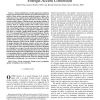Free Online Productivity Tools
i2Speak
i2Symbol
i2OCR
iTex2Img
iWeb2Print
iWeb2Shot
i2Type
iPdf2Split
iPdf2Merge
i2Bopomofo
i2Arabic
i2Style
i2Image
i2PDF
iLatex2Rtf
Sci2ools
TASLP
2010
2010
Developing Objective Measures of Foreign-Accent Conversion
Various methods have recently appeared to transform foreign-accented speech into its native-accented counterpart. Evaluation of these accent conversion methods requires extensive listening tests across a number of perceptual dimensions. This article presents three objective measures that may be used to assess the acoustic quality, degree of foreign accent, and speaker identity of accent-converted utterances. Accent conversion generates novel utterances: those of a foreign speaker with a native accent. Therefore, the acoustic quality in accent conversion cannot be evaluated with conventional measures of spectral distortion, which assume that a clean recording of the speech signal is available for comparison. Here we evaluate a single-ended measure of speech quality, ITU-T recommendation P.563 for narrow-band telephony. We also propose a measure of foreign accent that exploits a weakness of automatic speech recognizers: their sensitivity to foreign accents. Namely, we use phoneme-level m...
| Added | 21 May 2011 |
| Updated | 21 May 2011 |
| Type | Journal |
| Year | 2010 |
| Where | TASLP |
| Authors | Daniel Felps, Ricardo Gutierrez-Osuna |
Comments (0)

